
Red welts cover your skin, and you’ve seen little red-brown bugs crawling on the mattress, but are you sure you are dealing with bed bugs? Bed bugs can be mistaken for many other insects. Here are nine bugs that look like bed bugs and be sure to check out our section below where we ask the experts.
You need to know what pest you’re dealing with to develop your action plan. The last thing you want to do is pay for an expensive treatment that doesn’t target the nuisance pest.
What Do Bed Bugs Look Like?
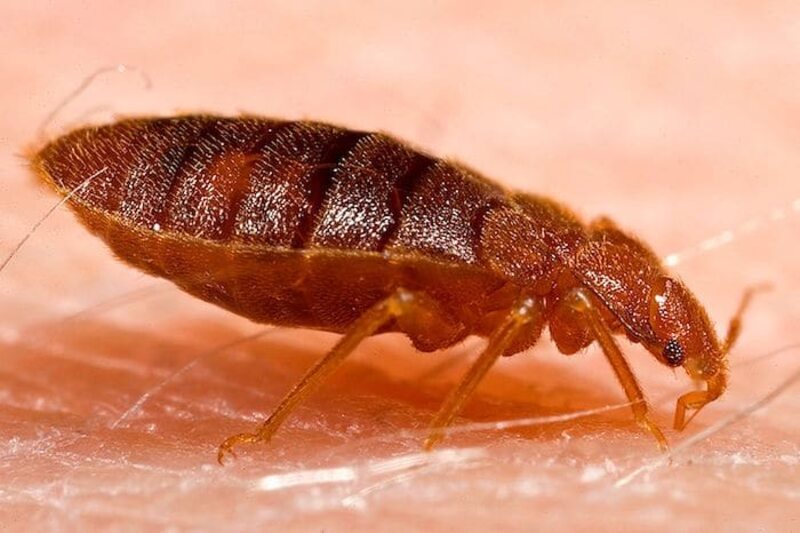
Photo Credit: Piotr Naskrecki / Wikimedia Commons / Public Domain
Bed bug nymphs are smaller than adults and are whitish-yellow. When full of blood, they look bright or dark red. Without any blood, their bodies are translucent and almost invisible. Bed bugs themselves are the size of a poppy seed when they hatch from eggs. Bed bug eggs are about the size of a pinhead or an apple seed and are pearl-white.
Now let’s take a closer look at 9 common insects that are often mistaken for bed bugs:
9 Bed Bug Look-Alikes
1. Baby Cockroaches
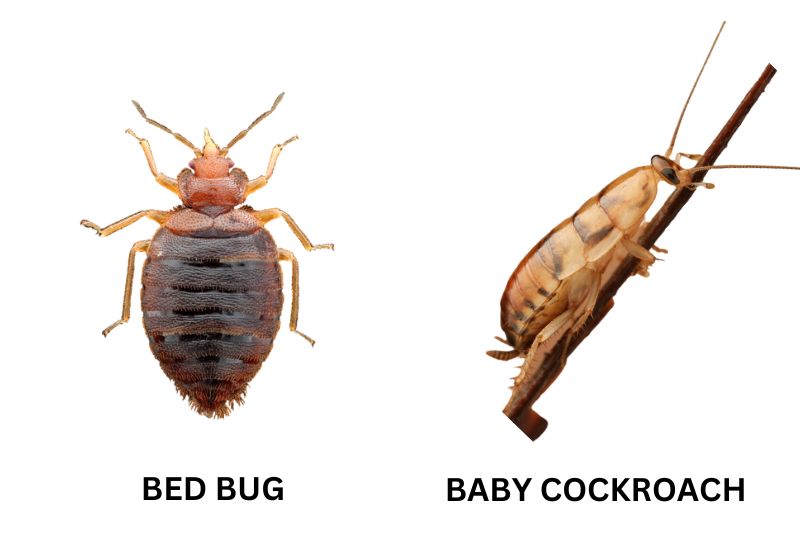
Bed Bug: AFPMB / Flickr / Public Domain
Baby Cockroach: patrickkavanagh / Flickr / CC BY 2.0
Baby cockroaches (cockroach nymphs) are often confused with bed bugs because of their similar coloring. These young varieties of the most common cockroaches include German, American, brown-banded, and Oriental cockroaches. Cockroaches have a flattened, oval appearance, long antenna, and long bristly legs.
Depending on the species, color ranges from reddish-brown to dark brown and from tan to black. Because they’re nymphs, they haven’t grown their cockroach wings, which also leads people to confuse them with bed bugs.
Where cockroach nymphs hide: Cockroaches thrive in moist areas, especially where food is prepared or stored. Prime breeding grounds include restaurants, grocery stores, commercial kitchens, sewers, and steam tunnels. You may even see cockroaches hiding in your crawl space, bathroom, or basement.
Cockroach nymphs in your home may be a sign of an infestation.
Health risk: Because bacteria sticks to a cockroach’s body, cockroaches may spread illnesses such as salmonella and gastroenteritis. People allergic to cockroaches may experience asthma attacks, according to the Asthma and Allergy Foundation of America.
2. Booklice
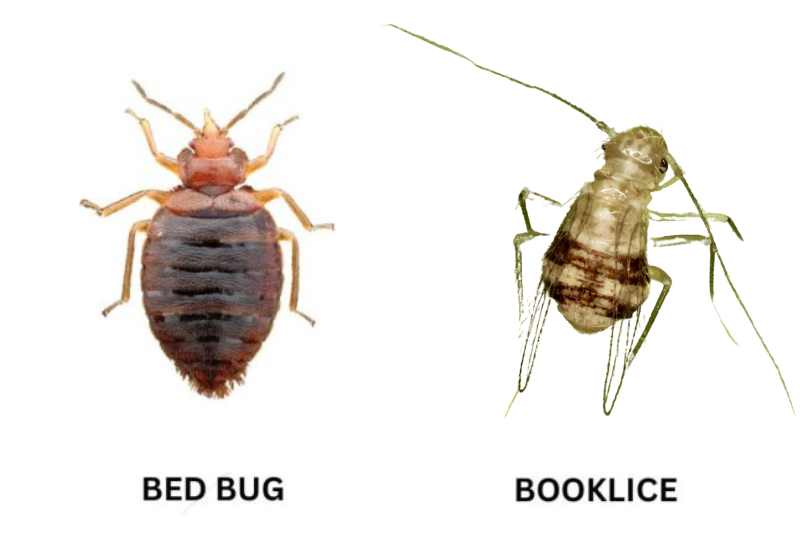
Bed Bug: AFPMB / Flickr / Public Domain
Booklice: Tomasz Klejdysz / Canva Pro / License
Booklice, which range in color from translucent white to gray or brown, are easily mistaken for adult bed bugs and baby bed bugs.
Where booklice hide: Booklice enjoy a moldy meal from the paste of old book bindings and wallpaper. If booklice are in your stored pantry items, this may be a sign mold is growing on your food.
Health risk: These bugs are a nuisance, but pose no threat. Their damage is typically minor.
Fun fact about booklice: Booklice, also called psocids, are not actual lice. Although they resemble lice in appearance, these little bugs feed on mold and fungi rather than blood.
3. Carpet Beetles
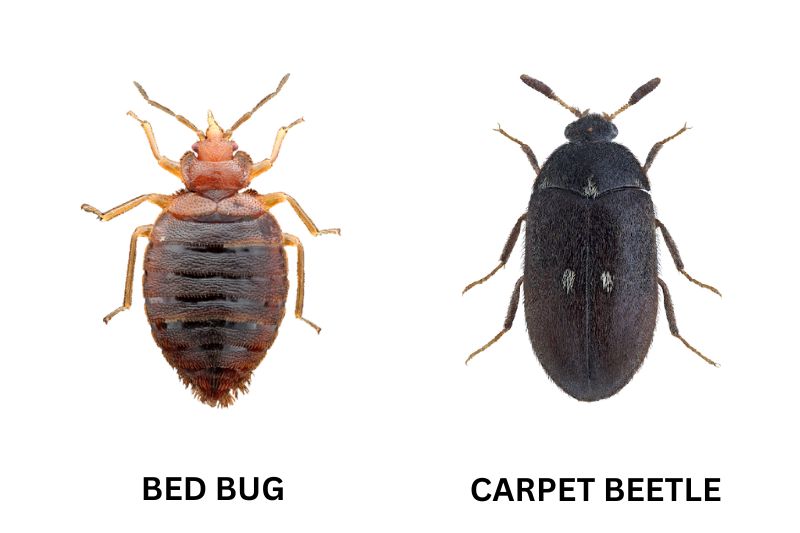
Bed Bug: AFPMB / Flickr / Public Domain
Carpet Beetle: Udo Schmidt / Wikimedia Commons / CC BY-SA 2.0
Adult carpet beetles vary in length, are oval-shaped, and can appear to be bed bug look-alikes. There are many species of carpet beetles, including the black, common, furniture, and varied carpet beetle.
These small pests feast on your animal origin materials, including furs, wools, feathers, or leather. Despite their name, they’re not fans of eating the synthetic materials of today’s carpet. They’ll make an exception, though, if your carpet has a blend of synthetic materials, animal fabrics, food, sweat, and oils.
Where carpet beetles hide: You’ll usually find carpet beetles around the edges of rugs and carpets, underneath upholstered furniture, or underneath baseboards.
Health risk: Carpet beetle larvae don’t pose much danger to you, but they can cause significant damage to your carpet or your favorite wool sweater. The damage usually appears in one ruined patch, rather than many scattered holes. Carpet beetles also leave behind molted shells.
4. Spider Beetles

Bed Bug: AFPMB / Flickr / Public Domain
Spider Beetle: Katja Schulz / Flickr / CC BY 2.0
Spider beetles may resemble a bed bug that has just feasted on blood.
What is a spider beetle? These bugs look like small spiders due to their long legs and large, rounded abdomens. The American spider beetle has a reddish-brown to black, shiny, globe-shaped abdomen and pale yellow legs, head, thorax, and antennae.
Where spider beetles hide: Spider beetles may forage in grain mills, pantries, warehouses, and attics that contain bird, rodent, or bat droppings.
Health risk: These pests can bite, and they may infest your foods.
5. Bat Bugs

Bed Bug: AFPMB / Flickr / Public Domain
Bat Bug: NY State IPM Program at Cornell University / Flickr / CC BY 2.0
Like bed bugs, bat bugs have an oval body and a short, broad head attached to the prothorax. The main difference between these two look-alikes is that bat bugs have longer (and more) hairs on their thorax.
Where bat bugs hide: Bat bugs develop in colonies of roosting bats, most often occurring in attics, behind walls, or in chimneys. When bats leave or are removed from the home, the remaining bat bugs may move into your living space and hide in dark crevices and fabric folds, including your mattress.
Health risk: Bat bugs primarily suck the blood of bats and will bite humans only if their bat host is unavailable. Although bat bugs are not known to transmit any diseases to people, their presence can cause anxiety and insomnia in some people.
6. Ticks

Bed Bug: AFPMB / Flickr / Public Domain
Tick: NIAID / Flickr / CC BY 2.0
Ticks are blood-sucking parasites, like bed bugs, and they can resemble each other until you look closely. The key difference? The number of their legs. Bed bugs, which are insects, have six legs; and ticks, which are arachnids, have eight.
Ticks not only feast on human blood but attach to pets, livestock, and wild animals, too. There are many types of ticks, each with different physical traits. Most ticks are small, dark in color, and flat when unfed.
Where ticks hide: Ticks are most commonly found attached to their host or outdoors in moist, shady areas with tall grass or overgrown vegetation. Occasionally a tick may be found indoors after being brought inside. Tick infestations indoors are rare, but they can occur if a female tick lays her eggs in your home.
Health risk: Ticks can pass many pathogens, such as Lyme disease, to people, pets, and other animals. If these diseases are left untreated, many can become life-threatening. It’s as essential to know how to remove a tick as it is to know how to identify a tick.
7. Fleas

Bed Bug: AFPMB / Flickr / Public Domain
Flea: Doc. RNDr. Josef Reischig, CSc. / Flickr / CC BY-SA 3.0
Fleas can be another bed bug impostor. Fleas can move quickly through fur, woven fabrics, and hair due to their narrow bodies, spiny legs, and backward-pointing bristles. Their hind legs make them excellent jumpers. These blood-suckers feed on cats, dogs, mice, birds, people, and many other warm-blooded animals.
Where fleas hide: Dogs offer a feast for fleas. Cats do too. In fact, pets are the chief way that fleas get inside homes from the outside. Look for flea larvae in floor cracks, carpets, mattresses, or pet beds. Fleas especially like places where they can feed on food, animal waste, and adult flea feces.
Health risk: Though rare, fleas are capable of passing diseases (including typhus and plague) to people. Some people and pets may also experience severe allergic reactions to a flea’s saliva. Your pet may experience anemia due to blood loss.
8. Head Lice
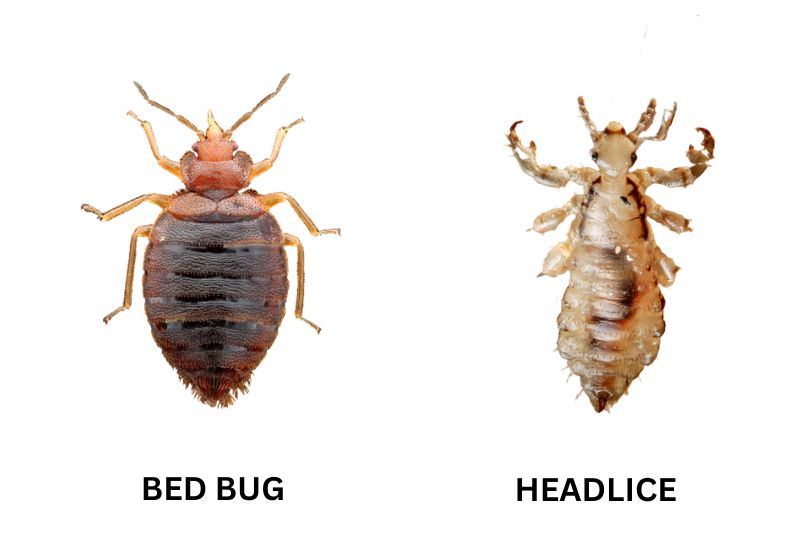
Bed Bug: AFPMB / Flickr / Public Domain
Head Lice: Gilles San Martin / Flickr / CC BY-SA 2.0
Is it a bed bug or lice? These two pests often are mistaken for each other. Lice are host specific, so lice infesting dogs can’t migrate to you, and you can’t transmit this pest to your dog.
Head lice affect only people and are typically gray but can take on their host’s hair color. The female is about 1/16 to 1/8-inch long, whereas the male is a bit smaller. Head lice cannot jump or fly. If you have head lice and don’t get treatment, the lice will continue to feed on your blood and may excrete dark red feces onto your scalp.
Where head lice hide: Head lice typically gather near the lower back of the head and behind the ears.
Health risk: According to the Centers for Disease Control and Prevention (CDC), head lice may cause severe itchiness in the scalp and lack of sleep. Excessive scratching may increase your chance of developing a secondary skin infection. Knowing safe and effective ways to remove lice can help you manage these risks.
9. Mites

Bed Bug: AFPMB / Flickr / Public Domain
Mite: Tokkes / Flickr / CC BY-SA 2.0
Mites and bed bugs can look similar to some people.
There are thousands of mite species, many of which live on animals. Mites are tiny, and many can be seen with the naked eye. They measure 2 mm (or less) in length, have eight legs, and have little to no segmentation.
Where mites hide: Mites have a free-range lifestyle. Some feed on decaying organic matter, whereas others forage on insects and other mites. Some mite species inhabit their host’s ear canals, lungs, intestine, and bladder, particularly in domestic animals.
Health risk: House dust mites can cause asthma. According to the World Health Organization, certain mites produce scabies, a contagious, intensely itchy skin condition in which tiny mites burrow into the skin.
Do You Have a Bed Bug Problem?

Photo Credit: Piotr Naskrecki / Wikimedia Commons / Public Domain
Although bed bugs have many doppelgängers, some signs may point to a bed bug infestation. For starters, where did you find the suspected bed bug? Not all bed bug look-alikes are hiding in the mattress, so where you find the bug can help you with identification.
Where to find bed bugs: If you found the bug in the bed, then odds are higher that you may have bed bugs. Is your head itchy? Then you’re probably not dealing with bed bugs. Keep in mind that bed bug bites are not enough to determine an infestation because bed bug bites look similar to mosquito bites and flea bites.
How to find bed bugs: Conduct your own investigation. What pest in the bug lineup of photos above is the best match? If it looks like the cockroach nymph, for example, you don’t have a bed bug problem but may have a different pest problem to solve.
Bed bug removal is costly, so be sure you are dealing with a bed bug and not a cockroach or other pest control problem.
How Much Does Bed Bug Treatment Cost?
Bed bug treatment costs around $5,300 for your whole home and approximately $310 for one room. The typical cost is between $917 to $1,917. It all depends on what the infestation looks like. Also, getting rid of bed bugs might take multiple treatments. To get an accurate idea of what you’ll spend, get a quote from local exterminators.
Ask The Experts
- How often have you experienced homeowners misidentifying bed bugs? What has proven (or can prove) to be the most significant consequence of misidentifying a bed bug?
- In your experience, what are typically the most common bugs that people mistake for bed bugs (or that people mistake bed bugs for)?
- Besides misidentification, what is a common mistake homeowners make regarding bed bugs and their homes?
- Bat bugs develop in colonies of roosting bats and will sometimes invade mattresses. They look a lot like bed bugs too. Is it common to find bat bugs in the home? Or, from your experience, is the infesting bug almost always bed bugs?




1. How often have you experienced homeowners misidentifying bed bugs? What has proven (or can prove) to be the most significant consequence of misidentifying a bed bug?
I do find that homeowners more regularly misidentify bed bugs or ask if an arthropod could be a bed bug. A survey done by Penn et al. 2017 found that travelers can identify bed bugs 28% or 35% [of the time], depending on if they were traveling for leisure or business, respectively.
2. In your experience, what are typically the most common bugs that people mistake for bed bugs (or that people mistake bed bugs for)?
More often than not, people mistake various small adult beetles for bed bugs. Although not adults, another example would be carpet beetle larva and their molted exoskeletons.
3. Besides misidentification, what is a common mistake homeowners make regarding bed bugs and their homes?
One common mistake that homeowners will make is they think that bed bugs will only be on or in beds. Then, move to a new sleeping area, thinking that the bed bugs will not move off the bed.
Despite their name, bed bugs will be present in chairs, couches, baseboards, on the ceiling, or on the floor, especially when infestations are high.
4. Bat bugs develop in colonies of roosting bats and will sometimes invade mattresses. They look a lot like bed bugs too. Is it common to find bat bugs in the home? Or, from your experience, is the infesting bug almost always bed bugs?
It is relatively uncommon to find bat bugs in your home, although it has been known to happen. The most recent example I encountered relates directly to your question. We had an inquiry about bat bugs in a duplex, which turned out to be bed bugs once were provided with a specimen.

1. How often have you experienced homeowners misidentifying bed bugs? What has proven (or can prove) to be the most significant consequence of misidentifying a bed bug?
Residents (I don’t use the word “homeowners” since many folks in my community don’t own their homes) sometimes misidentify other insects as bed bugs when bed bugs are suspected, especially if the insects occur near sleeping or resting areas indoors.
The most significant consequence of misidentification will be unnecessary pesticide application, which may lead to (unnecessary) pesticide exposure to people and pets.
2. In your experience, what are typically the most common bugs that people mistake for bed bugs (or that people mistake bed bugs for)?
Carpet beetles and their larvae are the insects most misidentified as bed bugs, in my experience, perhaps because they can be found in similar habitats (in and around beds and resting places).
Other arthropods commonly misidentified as bed bugs include psocids (Psocoptera: aka “booklice”), German cockroach nymphs, and other small bugs such as false chinch bugs (Lygaeidae) and minute pirate bugs (Anthocoridae). Bat bugs are very easily confused for bed bugs, but I’m not sure how commonly this occurs.
3. Besides misidentification, what is a common mistake homeowners make regarding bed bugs and their homes?
There are lots of “mistakes” people make about bed bugs. Most fall into the category of “believing bed bug myths.”
Common bed bug myths include “bed bugs are invisible,” “bed bugs spread disease,” “bed bugs are associated with poor sanitation,” and “insecticides are very effective at controlling bed bugs.” All these myths are false.
Other than the mythology, the biggest mistakes include throwing out infested (or perceived to be infested) items rather than treating them, spreading bed bugs around by changing sleeping or resting locations (due to avoidance of the primary infestation or infested space), trying to DIY bed bug control, overapplying or misapplying insecticides (including diatomaceous earth), and failing to report bed bugs in a rental housing situation.
4. Bat bugs develop in colonies of roosting bats and will sometimes invade mattresses. They look a lot like bed bugs too. Is it common to find bat bugs in the home? Or, from your experience, is the infesting bug almost always bed bugs?
Since most homes do not harbor bat roosts, I believe it is uncommon for residents to find bat bugs, especially inside homes. With that said, bat bugs are commonly associated with bats, so if there are bats living in a structure, it is entirely possible that the bugs may wander into a sleeping or resting area via cracks and crevices from bat roosts in attic or interstitial spaces.
I have dealt with a few confirmed bat bug observations over the years. In all cases, only one wandering adult bat bug was found. If multiple bugs are found, and especially if juvenile bugs are observed, this strongly indicates bed bugs.

1. How often have you experienced homeowners misidentifying bed bugs?
What has proven (or can prove) to be the most significant consequence of misidentifying a bed bug?
Prof. Nair: Quite frequently. Misidentified arthropods or other objects include bat bugs, fleas, cockroach nymphs, shiny spider beetles, ticks, and apple seeds.
The most significant consequences of misidentification are unnecessary panic and pesticide exposure, and wasted time, effort, and resources.
Prof. Gouge: Same, in fact I’d estimate that about 1 in 3 suspected bed bugs are something else. Which is less than it used to be 15 years ago.
2. In your experience, what are typically the most common bugs that people mistake for bed bugs (or that people mistake bed bugs for)?
Prof. Nair: Ticks and fleas (because of the bites) and German cockroach nymphs (because they are very frequently found to infest homes together.
Prof. Gouge: Same, most commonly German cockroach nymphs (immature babies).
3. Besides misidentification, what is a common mistake homeowners make regarding bed bugs and their homes?
Prof. Nair: Do-it-yourself treatment attempts to get rid of bed bugs, and not enough diligence in preventing them from entering homes (e.g. after travel, sharing furniture or clothing, improper disposal of infested items).
Prof. Gouge: Over the counter pesticides, or leaving the home and inadvertently taking bed bugs with them somewhere else. Or hoping they will starve them out.
4. Bat bugs develop in colonies of roosting bats and will sometimes invade mattresses. They look a lot like bed bugs too. Is it common to find bat bugs in the home? Or, from your experience, is the infesting bug almost always bed bugs?
Prof. Nair: It depends a lot on the condition of the home and the environment. For example, if the home is in a location frequented by bats, and does not have adequate bat-proofing, then bat bugs can be encountered. These types of situations are found more in suburban or fringe communities and rural areas.
Of course, bats can inhabit almost any type of urban environment if they have the chance to, but most modern neighborhoods don’t encounter them very frequently. Thus, the majority of infestations are indeed, of bed bugs.
Prof. Gouge: Cimicids associated with birds are more commonly sent relative to bat bugs.
FAQ About Bed Bugs
It takes only one bed bug on your clothes, in your luggage, or inside your purse to hop a ride into your house. You can get bed bugs from anywhere really – motels and hotels, college dorms, or even bargain yard sales via that nifty sofa you needed for your family room.
If you see a bed bug wandering on your floor or wall, it may be a straggler looking for a place to build its empire (that is, a bed or sofa). If your home is already infested, the best signs of bed bugs are their fecal droppings, which look like tiny black spots on fabrics.
Before you can even begin to get rid of bed bugs, you must make sure that it’s bed bugs infesting your house, but after that, you deep-clean, including vacuuming. That’s often not enough, for even one female bug can start another infestation. You must choose an extermination method, such as cold or steam. But your best bet is plain ol’ prevention.
When to Call a Pest Control Pro
When your bug investigation hits a dead end and you’re stuck identifying the bug you found, call an expert.
A pest control professional near you can help identify the bug that caused your welts, draft a treatment plan, and close the case of the mysterious bug you found in your home.
Main Photo Credit: Aleksey Gnilenkov / Wikimedia Commons / CC BY 2.0